
Section 2. Measures against New Infectious Diseases
1. Establishment and Implementation of New Laws on Infectious Diseases
(1) Legal system
In Japan, measures against infectious diseases had been taken mainly in compliance with the Communicable Disease Prevention Law that was enacted in 1897. These laws, however, can no longer meet the needs of the times. To say the least, over thirty emerging infectious diseases (Ebola hemorrhagic fever, AIDS, hepatitis C, etc.) have emerged around the world since 1970, while infectious diseases that had been thought to have already been conquered (tuberculosis, malaria, etc.) are threatening the human once again as reemerging infectious diseases. In the meantime, circumstances around infectious diseases have shown drastic changes. Such changes include the progress of medicine and medical treatments, improved level of public health and understanding by the nationals upon health, demands for respecting human rights and making the administration fair and transparent, more vigorous international exchanges, and the advent of a quick and massive transportation age supported by airplanes. To reflect such changes, the measures against infectious diseases based upon the "Communicable Disease Prevention Law" were completely revised. At the same time, the "Venereal Diseases Prevention Law" and the "Law Concerning the Prevention of Acquired Immunodeficiency Syndrome" (AIDS Prevention Law) that independently regulated measures related to respective diseases were abolished or integrated. Thus, the "Law Concerning the Prevention of Infectious Diseases and Patients with Infectious Diseases" (New Law on Infectious Diseases) was enacted, to replace these laws and promote measures against infectious diseases in a comprehensive manner.
- 1 Basic ideas of measures against infectious diseases
- Traditional measures against infectious diseases were often based upon the idea giving priority to the prevention of massive infection of each group. Nonetheless, many of the infectious diseases can be prevented and treated today. Accordingly, such an idea has been replaced by that of emphasizing the promotion of infectious disease prevention for the society as a whole, which is based upon repeated efforts for the prevention of diseases for each national and early treatments through the provision of high quality and appropriate medical treatments. It is also important to promote the collection and analyses of information on infectious diseases and let the public know the results.
- 2 Establishment of advance measure-based administration
- The New Law on Infectious Diseases provides for a shift to advance measure-based administration, under which measures are taken at ordinary times for the prevention of the outbreak and expansion of infectious diseases, from the traditional ex post facto measure-based administration under which measures are taken after the outbreak of an infectious disease. As part of efforts for such a shift, the government will upgrade the research system on outbreaks of infectious diseases and provide the public and medical professionals with information necessary for the prevention of infectious diseases based upon the analyses of collected information. It has also been agreed that the national government will present basic principles in comprehensive promotion of measures for the prevention of infectious diseases while prefectural governments will map out prevention plans in line with the basic principles, in order that systematic measures can be taken against infectious disease. In addition, as for AIDS, sexually transmitted diseases, and influenza, principles for the prevention of specific infectious diseases are to be mapped out so that the national government can take comprehensive measures in future.
Table 6-2-1. Laws on Medical Treatments for the Prevention of Infectious Diseases and Patients with Infectious Diseases and Definitions and Classification of Subject Infectious Diseases
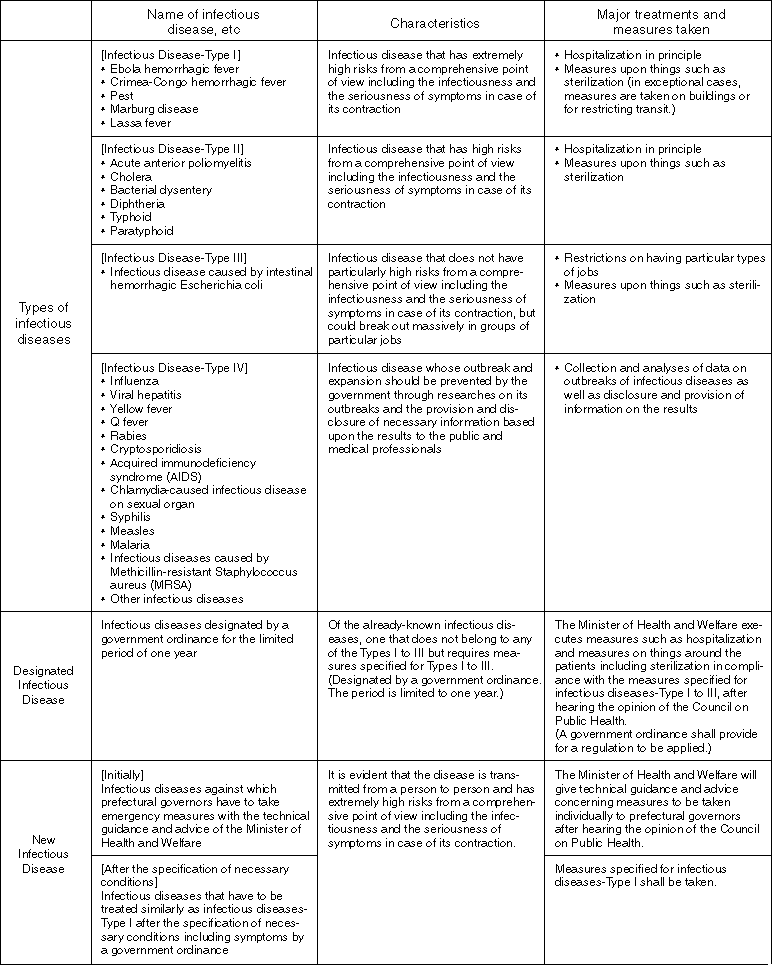
- 3 Types of infectious diseases and reestablishment of medical system
- The New Law on Infectious Diseases classifies subject infectious diseases into Types I to IV based upon their infectiousness and the seriousness of symptoms in case of their contraction. Then, the law provides that measures such as hospitalization and restrictions on working shall be taken in accordance with the type.
- Medical treatments for infectious diseases have been given mainly at isolation and quarantine hospitals established by municipalities. It has become necessary by now, however, to protect the human rights of patients, etc. while providing high quality, appropriate medical treatments. Accordingly, medical treatments for infectious disease patients have to be given as part of general medical services, while taking necessary measures for preventing further infection. In light of these, the New Law on Infectious Diseases does not restrict the organizations that can establish a medical institution for the treatment of infectious diseases to municipalities, but has introduced a system to allow prefectural governors to designate the most appropriate medical institutions. At the same time, the system for bearing medical expenses has been changed from the traditional system supported exclusively by public funds to the one of concomitant use of public funds and social insurance. In addition, some systems to secure human rights of patients suffering an infectious disease have been established. They include the systems of hospitalization recommendation based upon informed consent, emergency hospitalization with the limit of 72 hours, inspection by the council to check the necessity of hospitalization, and exceptional treatments of requests for inspections. These are to secure hospitalization formalities of patients.
- 4 Improving measures against animal-origin infectious diseases
- Many of the emerging and reemerging infectious diseases are animal-origin infectious diseases, whose infectious sources are animals. Some of such diseases, e.g. Ebola hemorrhagic fever that is known to be transmitted through monkeys, cause very serious symptoms and treatment methods for such diseases have not yet been established. As for measures on animals for the prevention of the transmission of infectious diseases to people, Japan had implemented measures only on dogs for the prevention of rabies. Increased international exchanges in recent years, however, have caused fears about the inflow of infectious diseases that had not constantly existed in Japan. In light of this, the New Law on Infectious Diseases provides for animal quarantine on monkeys etc. imported from abroad, in order to strengthen measures against animal-origin infectious diseases. In addition, the Rabies Prevention Law was partly amended together with the enactment of the New Law on Infectious Diseases. The amended Rabies Prevention Law stipulates that not only dogs, which have traditionally been subject to the law, but also cats, raccoons, foxes and skunks that could transmit rabies must be quarantined under the law.
- 5 Promoting international cooperation
- Problems of infectious diseases can no longer be solved by only one nation independently. They are global problems and international cooperation is essential in taking measures against them. Accordingly, the New Law on Infectious Disease clearly stipulates for international cooperation by the Japanese government in the collection of information and promotion of studies on infectious diseases as one of the obligations of the government. In addition, the diseases subject to quarantine (quarantine infectious diseases) under the amended Rabies Prevention Law include virus-caused hemorrhagic fevers categorized into Infectious Diseases-Type I under the New Law on Infectious Diseases, in addition to cholera, pest, and yellow fever that have traditionally been included. Thus, efforts are being made for strengthening the quarantine system to reflect world circumstances.
(2) Measures against AIDS
- 1 Actualities of AIDS
- The number of AIDS patients and people infected with HIV (human immunodeficiency virus) is estimated at 33.4 million worldwide as of the end of December 1998, while the number of people newly infected in 1998 is estimated at 5.8 million. An analysis by region shows that the patients in Africa south of the Sahara, South Asia, and Southeast Asia account for about 90% of all patients in the world. In some of the United States and European countries, the death rate of patients reportedly went down sharply and the number of new patients started declining in the same year. In Japan, however, the reported number of new HIV-infected people was 422 (second worst historically) and that of AIDS patients was 231 (third worst historically), showing that the infection is still expanding. One of the characteristics in recent years is that the ratio of infection though sexual contacts in Japan is getting higher in Japanese men.
Table 6-2-2. AIDS Patients and HIV-Infected People Worldwide

Figure 6-2-3. Changes in Infection Cases of Infected People including Patients
(Excluding infection cases caused by blood products)
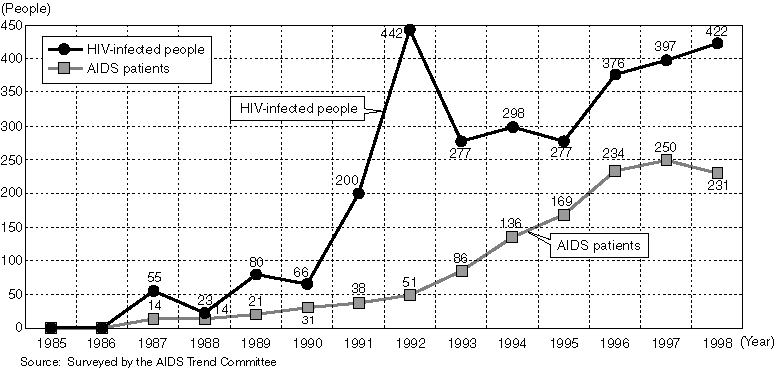
- As for treatments, the combined treatment using three drugs -two types of nucleoside reverse transcriptase inhibitors and one type of protease inhibitor or non-nucleic acid reverse transcriptase inhibitor- have become the most popular in advanced nations. This has contributed to a sharp decrease in the number of deaths due to AIDS. In Japan, as well, medical institutions that have introduced the three-drug combined treatment have realized a decrease in the number of deaths, suggesting the necessity of the diffusion of appropriate treatments.
- 2 Outline of measures for AIDS control
- The Ministry of Health and Welfare organized the Ministerial Conference on AIDS Control in 1987, for effectively promoting anti-AIDS measures, and mapped out the Basic Principles of a Comprehensive AIDS Strategy. Thus, the ministry set to comprehensive measures against AIDS in cooperation with other relevant ministries and government agencies. In addition, it launched "the Seven-Year Plan to Stop AIDS" in fiscal 1994. The targets of the plan to be achieved by 2000 include the development of specific drugs and vaccine, the prevention of AIDS diffusion in Japan, and support for the prevention of AIDS diffusion in Asia.
- As for legal measures, the Law Concerning the Prevention of Acquired Immunodeficiency Syndrome (AIDS Prevention Law) was enacted in 1989, for the development of reporting system, etc. The law, however, was abolished as a result of the enactment of the New Law on Infectious Diseases in 1998. Under the New Law on Infectious Diseases, AIDS is classified into Infectious Disease-Type IV and it has been agreed that comprehensive measures will be taken against AIDS.
- a. Improving medical system
- In response to an increase in AIDS patients and HIV-infected people, private rooms for AIDS patients and HIV-infected people are being increased, for the protection of privacy of patients as well as the prevention of intramural infection. At the same time, test equipment for prompt diagnoses of AIDS and other necessary equipment are being introduced. In addition, medical professionals are receiving various training for the improvement of diagnostic ability of model hospitals for AIDS treatment.
- b. Improving consultation and guidance system and test system
- Private consultation rooms have been opened at health centers for the protection of secrets of AIDS patients, HIV-infected people, and people worried about infection. The consultation system is also being improved, as shown by special training given to staff members who conduct individual consultation and by acceptance of consultation from foreigners staying in Japan. In addition, health centers conduct anonymous tests and individual consultation for free in principle, while all blood donated have gone through antibody tests since 1986.
- c. Promoting studies and international cooperation
- Studies and researches for AIDS control have covered a wide variety of areas including the prevention of the appearance of symptoms, the establishment of treatment methods, and the elucidation of the infection types. These studies have been based upon the report by the Expert Meeting on AIDS Control (1987), which is titled "Basic Principles for the Promotion of AIDS Studies". Results of such researches and studies have been reflected in the development of vaccine and the application of treatment methods to practical cases. At the same time, the Ministry of Health and Welfare is providing support to AIDS control measures worldwide for promoting international cooperation in such measures, through subscription to the Joint United Nations Programme on HIV/AIDS (UNAIDS) and training for officials and researchers in charge of AIDS control measures in Asia where the infection is rapidly expanding.
- d. Diffusing right knowledge
- The infection of AIDS can be prevented by behavior based upon right knowledge. This makes it essential to certainly provide nationals with right knowledge necessary for the prevention of infection. At the same time, it is necessary to eliminate discrimination and biased views against AIDS patients and HIV-infected people, which have persistently existed. In light of these, the ministry is doubling its efforts for affording a better understanding of infected people, while insisting in particular on the necessity of coexistence with patients and infected people.
- e. AIDS control measure promotion projects by prefectural governments
- The ministry is supporting comprehensive measures for AIDS control in respective regions, for comprehensively promoting carefully designed measures in accordance with the actualities of respective regions. For example, the ministry has given subsidies for the AIDS Control Promotion Council by prefectural governments, practical training and a variety of publicity activities for medical professionals, and the promotion of test and consultation activities, etc.
- f. Promoting comprehensive measures under the New Law on Infectious Diseases
- In response to the enforcement of the New Law on Infections Diseases, researches have been conducted upon outbreaks of AIDS, while the "Principles in Prevention of Specified Infectious Diseases in Relation to Acquired Immunodeficiency Syndrome" has been mapped out. Comprehensive measures will be taken according to the principles, for the prevention of outbreaks and expansion of AIDS, provision of medical treatments, promotion of R&D, international cooperation, and so forth.
2. Measures against Tuberculosis Entering a New Phase
(1) Reemergence of tuberculosis
- 1 Declaration of a state of emergency by WHO
- One third of all the people around the world have already been infected with tuberculosis, with 8 million people newly showing symptoms every year. In light of the worldwide prevalence of tuberculosis, the World Health Organization (WHO) declared a state of emergency in 1993. "If we do not take any measures now, 30 million people are likely to die in the ten years from now on," said the WHO, and called for the strengthening of measures against the disease. As for the reasons for the expansion of the disease, the negligence of measures against it, the emergence of multi drug-resistant tuberculosis, etc. have been pointed out.
- "Tuberculosis and malaria, which we had mistakenly believed to have conquered, have revived with refreshed ferocity," and "Drug-resistant bacteria have increased drastically in the last ten years, fatally damaging measures against tuberculosis," says the WHO. The WHO has expressively stated that it would promote "Directly Observed Treatment, short-course (DOTS)" as the global strategy against tuberculosis as a reemerging infectious disease. In DOTS, a trained expert will give drug administration guidance every time each patient takes the drug.
DOTS: Trained medical professionals directly give guidance to patients, e.g. by visiting them, and implement strong short-term chemotherapies while confirming that each patient surely takes the medicine. This is, to prevent the recurrence of tuberculosis and the emergence of drug-resistant bacteria as a result of incomplete medical treatments such as the suspension of dosages and medical defection. This method has produced significant results in developing nations, slums of advanced nations, and so on.
|
- 2 Tuberculosis patients increased for the first time in 38 years in Japan.
- In Japan, as well, tuberculosis is the most prevalent infectious disease, with the number of new patients in each year reaching around 43,000 and the number of deaths standing at about 3,000. Tuberculosis, which had been feared as a national disease, decreased rapidly in and after the 1950s, owing to the development of treatment drugs and the promotion of measures against it. The declining tendency, however, started slowing down in the 1970s. The number of new patients as well as the morbidity even went up in 1997, for the first time in 38 years as for the number of patients and in 43 years for the morbidity.
Figure 6-2-4. Changes in Tuberculosis Morbidity
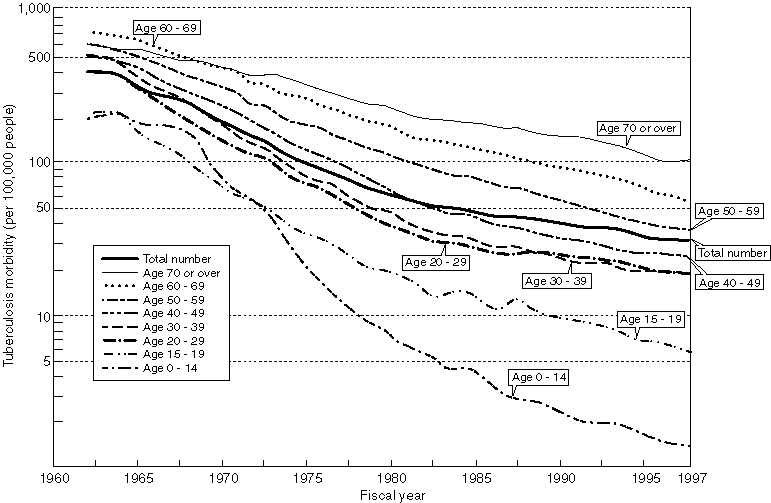
- The direct cause for the recent increase in the number of patents is considered to be an increase in old patients aged seventy or older. But the morbidity for the people mainly in their twenties to fifties has not declined, either. This reflects an increase in urban-type tuberculosis problems such as massive infection and contraction of the disease by people without fixed residence. Problems of foreign tuberculosis patients and tuberculosis as a complication of AIDS have also been pointed out.
(2) New phase of tuberculosis in Japan
- 1 Increase in tuberculosis in the elderly
- Tuberculosis used to be a disease for young people. Today, over 50% of new patients are old people, who tend to have many complications. Most of the tuberculosis cases are not caused by recent infection. Tuberculosis bacteria which old patients caught when young and that had remained dormant in their bodies until recently become active as they become physically weaker because of aging. As for tuberculosis of the elderly, over 10% of the patients die within a year after they become symptomatic, and many of the patients are in serious states.
-
Figure 6-2-5. Ratio of the Elderly in Newly Registered Patients
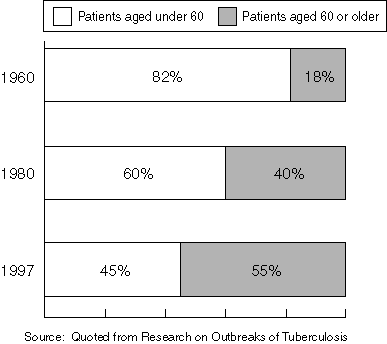
- 2 Serious tuberculosis in cities
- Big cities around the nation have some districts where people without fixed residence or single people with unstable employment are concentrated. The tuberculosis morbidity is high in such districts. Many of the patients in such districts are in serious conditions because of a delay in detection. Some even refuse or suspend medical treatments, which frequently leads to recurrence of the disease or creates drug-resistant bacteria. Some have pointed out concerns about a lower cure rate and secondary infection to other people in such districts.
-
Figure 6-2-6. Changes in the Number of Outbreaks of Mass Infection in Hospitals
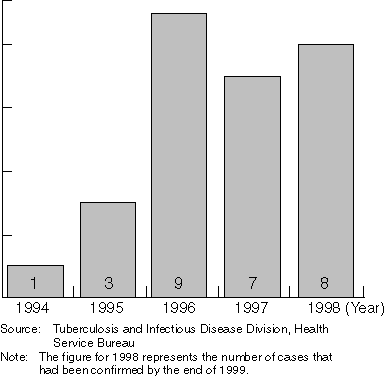
- 3 Increasing mass infection in hospitals
- Frequent outbreaks of mass infection of tuberculosis in hospitals or death cases have been reported recently. Many people are infected at medical institutions, which should essentially provide medical treatments. It should be also noted that in-hospital tuberculosis infection is troubling not only hospitals with beds for tuberculosis patients but also those without such beds.
- 4 Widening differentials among regions
- The difference among regions in prevalence is getting wider. The gap in morbidity by prefecture is 4.1 times. This reflects not only the original difference in prevalence but also differences in respective measures taken, such as physical checkups for patients' families and home-visit guidance.
- 5 Threats of multi drug-resistant tuberculosis
- Multi drug-resistant tuberculosis is a global problem now. According to some experts, the problem could lower the effectiveness of measures against tuberculosis back to that of the times before the development of anti-tuberculosis drugs. Fortunately, the rate of outbreaks has been maintained at an internationally lower level in Japan owing to the diffusion of appropriate medical treatments and efforts for preventing the suspension of medical treatments through home-visit guidance by public health nurses, etc. Nonetheless, the prognosis of patients is not favorable, with 22% of the patients dying within ten years after they become symptomatic. In light of this, the Ministry of Health and Welfare is endeavoring for the improvement of the medical system to cope with multi drug-resistant tuberculosis.
(3) New efforts
To cope with the new phase, the Tuberculosis Prevention Group of the Council on Public Health announced an emergency proposal in July 1998. Based upon this proposal, the Ministry of Health and Welfare has set to the promotion of measures against tuberculosis as a reemerging infectious disease.
<Outline of Emergency Proposal>
1 Measures against multi drug-resistant tuberculosis (construction of model institutions, etc.)
2 Active countermeasures for groups with high risks of catching tuberculosis (preventive dosage for the elderly and DOTS for people without fixed residence)
3 Enhanced collaboration and cooperative efforts among different regions, etc.
4 Measures against hospital infection (framing of principles for countermeasures)
5 Expansion of tuberculosis patient acceptance model projects, etc.
|
3. Measures against Drug-Resistant Bacteria
Many infectious diseases have been conquered since the beginning of this century as a result of the improvement of public health and the progress of medicine and pharmacology including the development of antibiotics. Nonetheless, the emergence of pathogenic microorganisms against which antibiotics do not work effectively, such as methicillin-resistant Staphylococcus aureus (MRSA) and vancomycin-resistant enterococcus (VRE), has surfaced as a new medical threat recently. In particular, measures against hospital infection have to be taken from a comprehensive point of view, covering not only traditional communicable diseases but also other various problems including opportunistic infection (infection by bacteria with weak infectiousness) that has become apparent as a result of the aging of patients, the progress of transplantation technology, etc. In other words, comprehensive efforts have to be made for the prevention of expansion of drug-resistant bacteria at medical institutions, through early detection of the emergence of drug-resistant bacteria and constant monitoring of outbreaks. Respective medical institutions and professionals have to make even more strenuous efforts to that end.
A wide variety of studies are under way, particularly at the National Institute of Infectious Diseases, upon various problems of drug-resistant bacteria that could trouble measures against hospital infection such as constant monitoring and analyses. It has been agreed that trials will be conducted in fiscal 1999 for launching a research on outbreaks of infectious diseases caused by drug-resistant bacteria. Other measures that have already been taken include short courses for medical professionals and the opening of intramural infection consultation windows.







